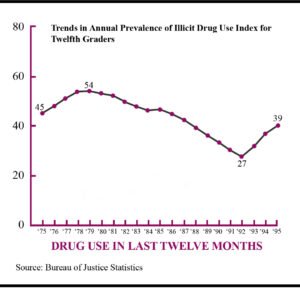[ad_1]
The next article was revealed on April 12 within the California Globe:
A review of the guide DARE to Say No: Policing and the Battle on Medication in Faculties (Max Felker-Kantor, The College of North Carolina Press) within the Could 2024 difficulty of Motive Journal seems to be again 42 years to the launch of a Reagan Administration’s effort to persuade faculty youngsters that taking medicine was a nasty concept. The article by Joe Lancaster describes Professor Felker-Kantor’s view that the DARE program, which introduced law enforcement officials into school rooms to debate the hazards of drug use, and the First Woman’s “Simply Say No” marketing campaign, which utilized public service bulletins and college curriculum to persuade children to keep away from unlawful medicine, have been each failures.
“In hindsight, DARE is primarily remembered as a joke, a bunch of cops appearing out hokey anti-drug skits. By 1994, a decade after this system’s founding, research clearly indicated that the DARE curriculum had little to no impact on charges of youth drug use,” writes Lancaster. “A lot of this system was due to this fact pushed by politics somewhat than any confirmed strategies of lowering drug use,” he added. The article then focuses on the detrimental elements of getting law enforcement officials in colleges, even suggesting that doing so was encouraging youngsters to tell on their dad or mum’s drug use.
However between 1982 and 1992, when these packages have been promoted by the White Home, colleges, and the media, one thing occurred that Mr. Lancaster and Professor Felker-Kantor uncared for to acknowledge. In accordance with the Nationwide Institute on Drug abuse, throughout that ten-year interval the variety of common cocaine customers dropped from 5.8 million to 1.3 million nationally. Common marijuana customers declined from roughly 22 million to eight.5 million. Equally dramatic declines in use have been seen with just about each different class of unlawful drug.
These declines have been in sharp distinction with information after the primary three years (1993-1995) of the Clinton Administration, when Division of Justice information present that hospital emergency room admissions for heroin and cocaine elevated by over 44%. Throughout that very same interval drug use amongst youngsters between the ages of 12 and 17 elevated by over 50%.
One clear distinction between the last decade of declining drug use and the reversal of that decline between 1993 and 1995 was nationwide drug coverage. It stays clear as we speak that the success of a nationwide effort to scale back drug use, particularly amongst youngsters, relies upon very a lot on who occupies the White Home. Through the Reagan/Bush years, the Battle on Medication was an administration precedence superior by laws, aggressive interdiction and prosecution, and a persistent effort to de-glamorize medicine and educate youngsters concerning the risks of drug use. Invariably, presidential speeches included each anti-drug messages and recognition for neighborhood activists preventing drug abuse domestically. Though Mrs. Reagan’s “Simply Say No” marketing campaign was broadly panned within the media as naive, I recall my elementary school-aged youngsters bringing dwelling posters and buttons with this anti-drug message and listening to them clarify over dinner how drug and alcohol abuse damage folks. I used to be delighted to listen to my children and their associates repeating the message of the very efficient public service tv, radio, and print adverts depicting a fried egg over the phrases “that is your mind on medicine.” Throughout this era, particularly with youngsters, utilizing medicine grew to become fairly “uncool.” The outcomes proved that with the right management a Battle on Medication may produce main reductions in drug use.
In 1993, considered one of President Clinton’s first official acts was to chop the Workplace of Nationwide Drug Management Coverage price range by 80%. Within the months that adopted, Clinton’s U.S. Surgeon Common, Joycelyn Elders, advised that Congress ought to think about legalizing medicine. This suggestion got here at about the identical time that her son was arrested on drug fees. A Could 12, 1996, Los Angeles Instances article reported that beneath the Clinton Administration, the Division of Justice coverage for drug smugglers caught at our border was to ship most of them again with out prosecution. And, after all, neither the President nor the First Woman appeared involved in carrying on any form of nationwide effort to discourage drug use amongst youngsters. As the previous head of the Drug Enforcement Administration, Robert Bonner put it, “beneath Clinton we went from simply say no, to simply say nothing.”
As we speak, roughly 100,000 People die annually from drug overdoses; 70,000 of them from fentanyl. Many of those victims are teen-aged youngsters and younger adults who have been by no means uncovered to any organized effort to warn them concerning the risks of drug use.
Whereas dad and mom play a major position in encouraging optimistic conduct from their youngsters, for a short interval within the Nineteen Eighties that they had priceless assist and help from the President, the First Woman, educators, advertisers, and legislation enforcement to say no to medicine. For tens of 1000’s of youngsters and their dad and mom, this made an actual distinction.
[ad_2]
Source link

